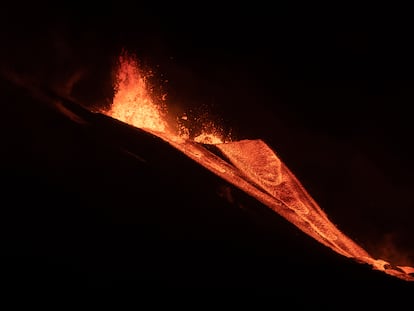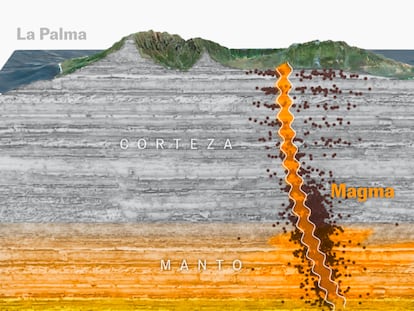How the volcanic eruption is affecting La Palma’s pine forests
Ash, gases and lava have destroyed large swathes of forested area, but experts say the sturdy ‘Pinus canariensis’ will be able to recover
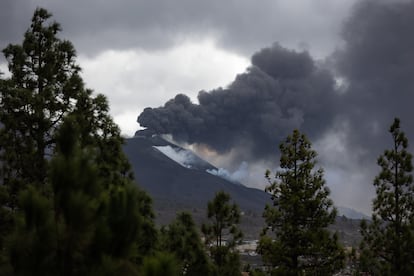
Marta Martín is a forest engineer and tourist guide, specializing in routes that take in La Palma’s rich natural heritage. “I usually explain to groups that La Palma is a small continent, with a massive variety of landscapes,” she says. “We have arid land to the south, which is almost desert-like, and areas that resemble jungles, such as the laurel forests in the north.”
This scenic melting pot is due to the radical difference in humidity between areas that are irrigated by the trade winds and those where these winds have been obstructed by the island’s altitude of up to 2,426 meters. “That variety is what makes us la isla bonita [the beautiful island],” Martín adds, referring to the name by which La Palma is affectionately known. One of the many types of vegetation that covers La Palma’s 708 square kilometers is pine forest. It occupies 34.7% of the forested area of La Palma, which has been devastated by the eruption of a new volcano in Cumbre Vieja natural park.
Since the volcano began to erupt on September 19, it has razed more than 1,555 hectares and destroyed 2,897 buildings, according to the European satellite system Copernicus. On Sunday, experts warned that a vent to the east of the main cone had reactivated and was emitting more lava. While, Carmen López, the spokesperson of the Volcano Risk Prevention Plan of the Canary Islands (Pevolca), which is overseeing the crisis, said on Saturday, that the eruption shows no sign of easing.
The volcano is located in an area populated by forests of the Canary Island pine tree (Pinus canariensis), which quickly became fuel for the volcano’s fire. “It was a young pine forest, with scattered trees,” Martín explains. But the destruction of the forest has not been limited to the trees swallowed by the lava. “The acid aerosols it expels are causing the pines to suffer from terrible chlorosis [yellowing due to lack of chlorophyll],” explains Félix Medina, a biologist with La Palma’s island authority, who is studying the daily impact of the eruption on the natural environment. Gases expelled from the volcano, such as sulfur dioxide, are carried by the wind, “crushing” pine forests located up to seven kilometers from the crater, he says.
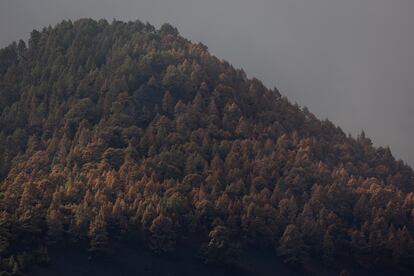
The caprices of the wind mean that there are areas far from the volcano that are “badly affected” and others close to the lava flow that seem healthy, according to Medina. “We don’t know how the abrasion is going to affect the photosynthetic processes of the pine forest,” he says. “We are finding out little by little. This is the first time we have experienced such a monstruous event in real time and directly. Many pines will end up dying because of it, but we will still have to wait for some time before we know the extent. We have also detected episodes of acid rain in very specific areas that are damaging the pines.” He adds: “Behind the cone [to the east], there is a large concentration of pine trees that are suffering from the relentless impact of materials expelled from the bowels of the island.”
The volcano’s other weapon against the forest is ash: “If you put a black surface on any plant species that prevents it from photosynthesis, it will suffer, whether it’s the geranium you have at home, or these pines,” says Martín. “Without light, their metabolism changes. You also have to take into account that much of the vegetation is completely buried by the ash. We don’t know how many meters [of ash] on their roots the pines will be able to withstand. This is aside from the toxic gases to which they are being subjected.” The ash also acts like sandpaper against the leaves and shoots that are trying to grow after the destruction.

The eruption has hit pines that were not at their strongest due to a combination of factors. “The pine trees, and all the vegetation, have been hit by the eruption at a vulnerable time,” says Medina, who is conducting a field study with biologist Manuel Nogales from the Spanish National Research Council (CSIC) to analyze the volcano’s effect on the ecosystem. “We are emerging from a very dry summer after a very long period of drought. Rainfall has been very low since 2013, which is not at all common on La Palma. This has led to a series of fires that have further compromised the pine forests.”
The experts consulted by EL PAÍS do, however, have faith that the pines not consumed or buried by the lava will recover. The specimens that populate La Palma are Canary Island pines, which are taller and more resistant than their peninsular siblings (such as the Aleppo pine, stone pine and Monterey pine). “The Canary Island pine is taller and slimmer; salmon colored when young and silver when it matures. You don’t realize its immense size until you get close to it,” explains the director of the Caldera de Taburiente National Park, Ángel Palomares, who stands next to a gigantic 800-year-old specimen.
Another of the features that differentiates the Canary Island pine is that it has three very long needles per sheath, while the Aleppo or stone pine have two shorter ones.
Caldera de Taburiente National Park is the jewel of La Palma – a sea of pine trees in the middle of the island. “The most superb pines which are also more numerous are in the northern zone [the wettest],” he says. “They grow up to 40 meters tall. There are other areas with very tall pines in Spain, such as the Sierra de Guadarrama, but they are not so numerous and as concentrated as in La Palma.” This mantle that paints the island green also extends to the north, beyond the park. With 39.5% of its surface area covered by trees, La Palma is the island with the highest percentage of forested area in the entire Canary archipelago, which is located off the coast of northwestern Africa.
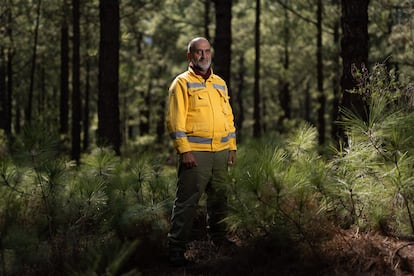
Palomares states that most of the pine forests affected by the volcano will survive. “They may be battered and deformed, as if a volcano had trampled over them, but it is a very resistant species,” he says.
Martín agrees: “The Canary Island pine is stronger than other pines. Its bark, which covers the trunk, protects it from fire. Within it, epicormic buds are produced that facilitate its recovery. You can come across a pine whose biomass is dry and its branches broken with no needles, which will later revive.”
Palomares is a direct witness to the power of the pine: he makes daily trips to the area around the eruption, where he finds many that have been affected: “The ones closest to the crater are like toothpicks; they don’t have a single branch,” he says. “With some of them, you can see shoots. The pine has to be badly damaged to die; it is very resistant. We already knew this from the fires [during the summer]: the bark insulates to the extent that the tree can survive 400ºC heat. We have scraped some crushed specimens and found they are not dry. They are in a diapause [physiological state of inactivity to survive unfavorable conditions], waiting to see what happens.”
Aside from those devastated by lava, buried in ash or sulfur dioxide, the pine forests that have perished from the eruption are those whose roots have been scorched by magma moving to the surface.
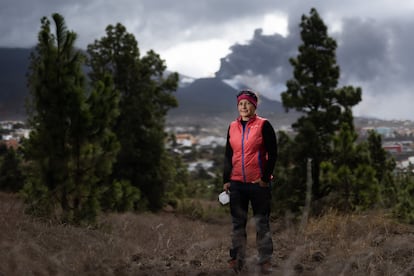
Nobody knows the exact extent of the natural area affected by the eruption. Most of the devastated zones have been residential or agricultural, but there are also areas of pine forest and other natural spaces that did not escape unscathed. The ashfall has been calculated to extend over more than 1,100 hectares, although this does not include areas buried by meters and meters of ash that has rained constantly upon it. Two weeks ago, results from Medina’s research revealed that the pine is the most plant most affected by the eruption, while the lizard has fared worst in the animal kingdom. “They move in confined spaces,” he says. “If there is a threat, they hide, so they get buried in ash or under the ash.” In spite of everything, La Palma’s endemic or threatened species have not suffered. Among them are plants such as the Cicer canariensis and the Parolinia aridanae, and animals such as the El Remo grasshopper.
Either way, most of the island’s natural life has soldiered on. “Almost none of the vegetation is going to have problems,” says Palomares. “There are plants far away that are being showered with ash, but nothing is going to happen to them.”
According to Medina, “la isla bonita will continue to be beautiful. Nature here on this island is used to volcanos. It is we who are not used to it. We would all have liked the lava to have come out south of [the town] Fuencaliente, so that it would not have affected so many people. But the island and its species are used to volcanic events, so the vegetation has evolved and come through.”
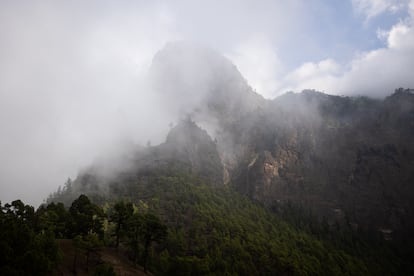
Plants will eventually conquer the now incandescent rock. “One of the first organisms to populate the lava flow is the lichen,” says Martín. And, according to Palomares, the first plant that grew after the Teneguía eruption in 1971 was Rumex lunaria. “To know what is going to happen, we need to know which plants are left in the islands of uncultivated land in the middle of the lava flow, since they will become natural recolonization points,” says Medina.
And the pines? “It is more difficult for them to grow in the lava flow. They will, but they need much more time and large inputs of soil,” explains Medina.
Palomares agrees: “There are examples of pine trees in historical lava flows, but it is more difficult for them than for other plants,” he says. “In the pure lava flows, which are just rock without soil, colonization is slow.” The fact that the volcano is expelling so much ash may help the pine to reconquer areas that have been subjected to lava, according to Medina. But, however long it takes, the experts are confident that the island will continue to be the kingdom of the Canary Island pine.
Tu suscripción se está usando en otro dispositivo
¿Quieres añadir otro usuario a tu suscripción?
Si continúas leyendo en este dispositivo, no se podrá leer en el otro.
FlechaTu suscripción se está usando en otro dispositivo y solo puedes acceder a EL PAÍS desde un dispositivo a la vez.
Si quieres compartir tu cuenta, cambia tu suscripción a la modalidad Premium, así podrás añadir otro usuario. Cada uno accederá con su propia cuenta de email, lo que os permitirá personalizar vuestra experiencia en EL PAÍS.
¿Tienes una suscripción de empresa? Accede aquí para contratar más cuentas.
En el caso de no saber quién está usando tu cuenta, te recomendamos cambiar tu contraseña aquí.
Si decides continuar compartiendo tu cuenta, este mensaje se mostrará en tu dispositivo y en el de la otra persona que está usando tu cuenta de forma indefinida, afectando a tu experiencia de lectura. Puedes consultar aquí los términos y condiciones de la suscripción digital.
More information
Últimas noticias
From Andorra to Gibraltar, a black market for Ozempic exploits its success: ‘They’re the most sought-after products in the world’
From safe-haven investment to geostrategic weapon: Who owns the most gold and where are the bars kept?
Todd Green, head of the company that created ‘Candy Crush’: ‘Success for us is that players want to play for years’
Prices soar and Venezuela’s economy struggles under Trump’s pressure: ‘People are living day to day’
Most viewed
- Why we lost the habit of sleeping in two segments and how that changed our sense of time
- Charles Dubouloz, mountaineering star, retires at 36 with a farewell tour inspired by Walter Bonatti
- Venezuela faces its most tense Christmas yet
- CBS in crisis after pulling a report on Trump’s deportations to El Salvador (which later leaked online)
- Bukele clan fumes over investigation exposing their new wealth
